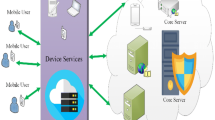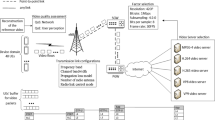Abstract
Ubiquitous computing platform enables interactions among users, applications, and services through wireless devices. People always connect to the Internet while moving. Although portable device can provide high-speed connectivity, a user may move into area with weak signal or thin bandwidth, which possibly hinder the reception of satisfactory multimedia traffic. In this paper, a ubiquitous computing platform is designed for quality control of multimedia and data context through the Internet to users. For the proposed platform to perform properly, traffic content should be classified into real-time or non-real-time, casual or critical, data or multimedia traffic type. Indeed, a session may consist of different traffic classes. Information for classifications may be identified through the communications between content providers and clients, or through direct communication between the platform and providers or clients. It is the goal of the proposed Quality of Service control framework which provides mechanisms for delivering satisfactory content to subscribers, through content adaptation and selections. The focus of this paper will be on setting real-time performance bound regarding multimedia traffic. Quality of images and videos can be adapted to fit different performance constraints in networks. Furthermore, traffic becomes redundant and useless when delivered information exceeds the delay tolerance of human beings. In our proposed platform, modifications are executed through agent technology inside the Internet. Thorough experiments have been carried out, and the impacts of real-time bounds are examined. Measured results indicate that the proposed framework works and meets the expectations of end-users.








Similar content being viewed by others
References
Banavar G, Bernstein A (2002) Software infrastructure and design challenges for ubiquitous computing. Commun ACM 45(12):92–96
Byers JW, Considine J, Mitzenmacher M, Rost S (2004) Informed content delivery across adaptive overlay networks. IEEE/ACM Trans Netw 12(5):767–780
Chen B, Cheng HH (2010) A review of the applications of agent technology in traffic and transportation systems. IEEE Trans Intell Transp Syst 11(2):485–497
Daly S (1993) The visible differences predictor: an algorithm for the assessment of image fidelity. In: Watson AB (ed) Digital images and human vision. MIT Press, Cambridge, pp 179–206
Fielding R et al (1999) Hypertext transfer protocol—HTTP/1.1, IETF, RFC 2616
ITU-T Recommendation P. 800 (1996) Methods for subjective determination of transmission quality. International Telecommunication Union (ITU-T)
Johnson D, Perkins C, Arkko J (2004) IP mobility support for IPv6, IETF, RFC 3775
Jrad ZE-F, Benmammar B, Correa J, Krief F, Mbarek N (2005) A user assistant for QoS negotiation in a dynamic environment using agent technology. In: 2nd IFIP international conference on wireless optical communications networks (WOCN), pp 270–274
Law KLE, Lau C (2010) Mobility service agent. In: 3rd IEEE workshop on wireless and internet services (WISe), in conjunction with 35th IEEE conference on local computer networks (LCN)
Lee J-S, Hsu P-L (2007) Implementation of a remote hierarchical supervision system using petri nets and agent technology. IEEE Trans Syst Man Cybern Part C 37(1):77–85
Lum WY, Lau FCM (2002) A context-aware decision engine for content adaptation. IEEE Pervasive Comput 1(3):41–49
Noble BD (2000) System support for mobile, adaptive applications. IEEE Pers Commun 7(1):44–49
Perkins C (ed) (2002) IP mobility support for IPv4, IETF, RFC 3344
Pratistha IM, Zaslavsky A, Cuce S, Dick M (2005) Improving operational efficiency of web services with mobile agent technology. IEEE/WIC/ACM international conference on intelligent agent technology, pp 725–731
Rahrer T, Fiandra R, Wright S (2006) Triple-play services quality of experience (QoE) requirements. DSL Forum, Architecture & Transport Working Group, technical report TR-126
Satyanarayanan M (2001) Pervasive computing: vision and challenges. IEEE Pers Commun 8(4):10–17
Author information
Authors and Affiliations
Corresponding author
Appendix
Appendix
Peak signal-to-noise ratio (PSNR) is an easy-to-use error measurement metric, and it is widely used for providing quantitative evaluation of receiving multimedia quality. It is a reasonable system performance measure for visual perception if signal errors are spread evenly across an image. However, upon observing the two rugby team pictures shown in Fig. 9a and b, both suffer identical overall loss conditions. The errors are spread across all pixels in Fig. 9a; therefore, it is visually more appealing than the one shown in Fig. 9b. These cases indicate the need of using subjective evaluation upon examining the design of our framework.
One possible filter responsive function is called Visual Differences Predictor (VDP) (Daly 1993), which can be adopted to model the retinal sensitivity of human being. The retinal response to luminance is a non-linear function, and it is used to evaluate the quality of distorted images. Algorithm derived for VDP attempts to indicate the probability of detecting a difference between the two images on a pixel-by-pixel basis. In our testing, we have adopted a simplified VDP version using a relative mean calculation. These computations may not be needed to run at all times; the image difference computations can be carried out during quality calibrations or upon user requests.
The luminous response, l(i, j) shown in (1), is called amplitude non-linearity value,
where L(i, j) is the luminance of the pixel (i, j) in dimension cd/m2. Typically assigned values for the parameters b and c 1 are 0.63 and 12.6, respectively. Spatial frequencies f l (u, v) can be obtained through the Fast Fourier Transform of the luminance sensitivity spatial pattern l(i, j). It gives the magnitude at horizontal spatial frequency at u and vertical spatial frequency at v. Human being is aware of changes in signal contrast. The contrast sensitivity function (C S ) is used to model the retinal contrast sensitivity to a spatial frequency.
where z = u 2 + v 2.
The C S , in (2), gives a two-dimensional spatial frequency plane (u, v). As shown in (3), the C S function filters the f l (u, v) values and obtains the parameter Filtered Magnitudes of the Amplitude Non-Linearity Value (FMANLV), g(u, v). The g(u, v) measures the luminance sensitivity filtered by the retinal response with respect to the spatial frequency (u, v), which is
1.1 Calibration operations
There are no needs to run these computations in real-time. In the proposed platform, the framework can initiate an initial calibration phase between subscriber and content provider. In other words, the ingress and egress agents can subsequently set appropriate preferences for a subscriber.
The multimedia content provider may send a reference image R with a reference g R (u, v) value. Then it sends other compressed testing image, C, with g C (u, v) at the recipient under the assumption of certain network conditions. Suppose this is the least accepted quality of a subscriber, then the egress agent can compute a relative image metric through normalizing the g C (u, v) of the test image with respect to the g R (u, v) of reference image. The resulting measure is called the relative root-mean square (RMS) error of the reference content,
A smaller R RMS (C, R) value indicates that the received image is visually closer to the original one. This quality bound of a streaming multimedia content can be set through finding the largest accepted R RMS (C, R) value of a content subscriber. This bounding measure is returned to the ingress agent for determining appropriate compression operations in future.
Rights and permissions
About this article
Cite this article
Law, K.L.E., So, S. QoS control framework for content satisfaction in ubiquitous multimedia computing. J Ambient Intell Human Comput 3, 103–112 (2012). https://doi.org/10.1007/s12652-011-0077-8
Received:
Accepted:
Published:
Issue Date:
DOI: https://doi.org/10.1007/s12652-011-0077-8





